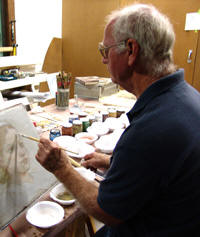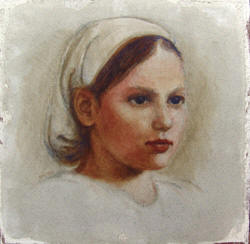| |
 "Life begins at the edge of your comfort zone" is a
phrase from the "Conversation with God" books. As an oil painter of 24
years experience, I am comfortable using a layered oil painting
technique that I developed over the years. My recent fresco class with
Ilia and Ian took me out of my comfort zone in oils and thrust me into
the uncomfortable realm of a new medium. "Life begins at the edge of your comfort zone" is a
phrase from the "Conversation with God" books. As an oil painter of 24
years experience, I am comfortable using a layered oil painting
technique that I developed over the years. My recent fresco class with
Ilia and Ian took me out of my comfort zone in oils and thrust me into
the uncomfortable realm of a new medium.
Fresco is more closely related to the watercolor
technique than it is to oils. Lighter tones are applied first, gradually
building up to the darks, whereas in my oil technique, darks are laid in
early, with lights built on top of the darks, in impasto. As a result of
my embedded perceptions from oil painting, my first fresco attempt was
humbling. We learn the most from our mistakes, so I learned a lot from
that first fresco:
-
The light, transparent tones are applied so light, they are barely
visible (to my eyes, which are 61 years old). As the plaster dries, the
tones become more pronounced. In my first attempt, I applied darker
values too quickly, and once the darks are brushed on, they're on.
Most of the medium is squeezed out of the brush before applying
brush to surface which is, of course, already damp (my first fresco
contained small dark pools of color at the end of practically every
stroke, from having too much medium in the brush).-
Strokes must be applied lightly, caressing the surface. I do this in
oils, so there was no adjustment necessary in this area.
-
It is possible to create quite a rich dark by slowly building-up the
tones. Since I work with the full value range in oils, I was pleased to
note that fresco allows a fairly extensive value range.
For my second fresco, I added white to each color, working with tints in
the light-to-middle value range for all but the eyes of the figure.
While I found this approach controllable, the result is opaque colors
which lack the purity and richness of the transparent colors.
My third fresco was of the same subject (a head) as the second, but I
used only transparent colors. For this attempt, I laid down the tones as
lightly as possible, working very slowly in building up the darks. This
study was more successful in that I was finally able to control the
tones more closely than before.

There is a stage in the learning process where the student begins to
"get it." I began to connect with the medium while working on my third
fresco. My fourth fresco was a panel with the intonaco prepared by Ian,
a surface so beautiful I almost didn't want to touch it. The thicker
layers of the panel absorb the paint a little differently and also meant
I had more working time (though the image I had chosen was so simple I
didn't need it). The act of drawing on the wet plaster and building-up
the delicate washes of color felt primal.
The preparation of the plaster surface for fresco is a critical part of
the learning process, and will require extensive practice to master. I
intend to prepare the surface of my own portable frescos, but as Ilia
says, a wall fresco that requires several days/weeks/months to complete
is best done with an assistant who is experienced in mixing and applying
the intonaco surface.
Fresco restrictions are many: the working environment must be controlled
(not too cold, not too hot, no sun, no wind), and only a small area may
be covered each day. Also, even small portable frescoes on panels are
heavy and fragile.
On the plus side, this is a medium made for murals, for walls and
ceilings. No other medium works as well in this context. Its longevity
cannot be matched. With proponents like Ilia making the medium more
visible, architects and interior designers will begin incorporating
fresco designs into more public and private buildings.
I live on the Big Island of Hawaii. As an oil painter, I exhibit and
sell through galleries in the islands. Now that Ilia has impressed on me
the potential of the fresco medium, I intend to master the technique,
create portable frescoes for gallery exhibitions and eventually murals.
This medium needs to be revitalized.
Ed Kayton
www.kayton-art.com
| |
Ed Kayton attended
"6-Day Private Class", part of our Professional
Fresco Program. |
|



